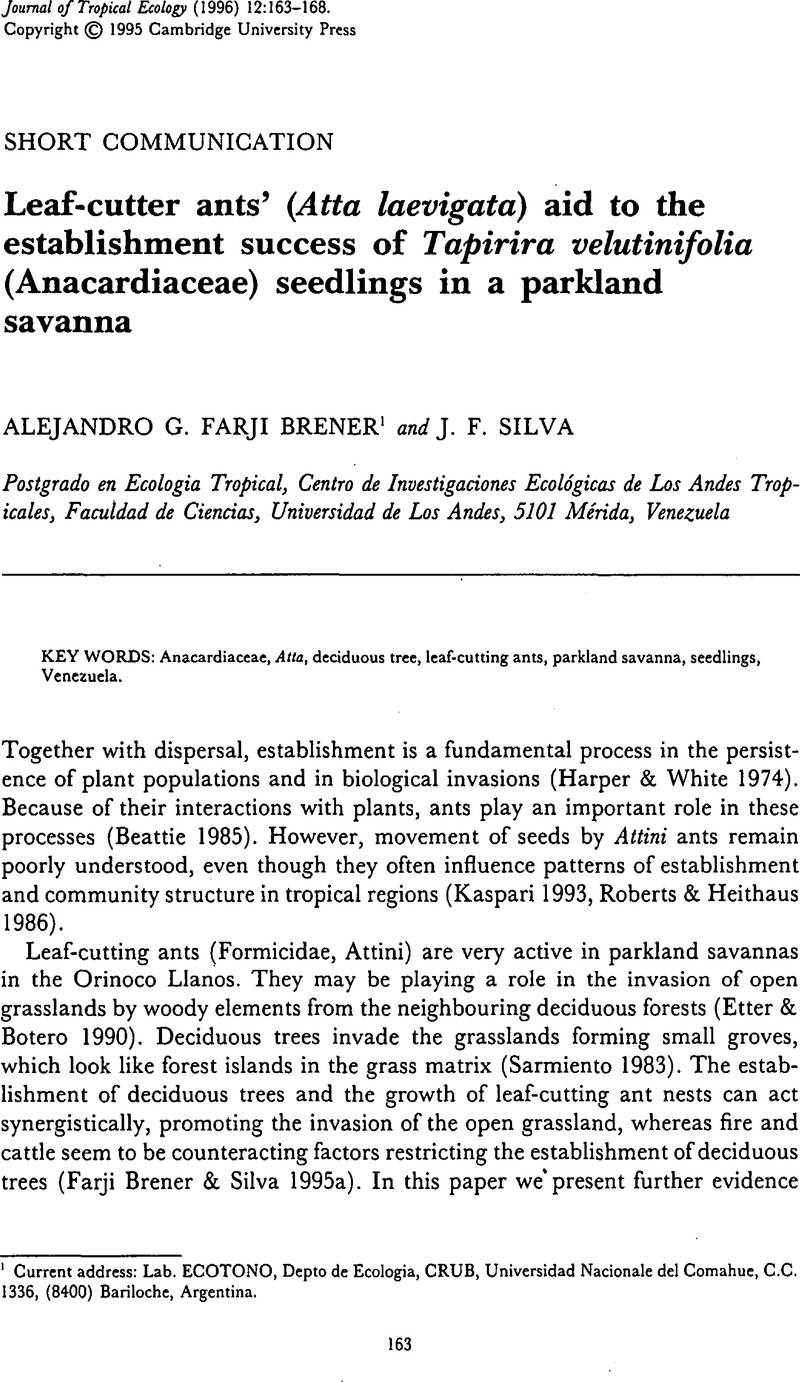Crossref Citations
This article has been cited by the following publications. This list is generated based on data provided by Crossref.
Furley, Peter
1997.
Plant ecology, soil environments and dynamic change in tropical savannas.
Progress in Physical Geography: Earth and Environment,
Vol. 21,
Issue. 2,
p.
257.
Pizo, Marco A
and
Oliveira, Paulo S
1999.
Removal of seeds from vertebrate faeces by ants: effects of seed species and deposition site.
Canadian Journal of Zoology,
Vol. 77,
Issue. 10,
p.
1595.
Pizo, Marco A.
and
Oliveira, Paulo S.
2000.
The Use of Fruits and Seeds by Ants in the Atlantic Forest of Southeast Brazil1.
Biotropica,
Vol. 32,
Issue. 4b,
p.
851.
Farji‐Brener
and
Illes
2000.
Do leaf‐cutting ant nests make “bottom–up” gaps in neotropical rain forests?: a critical review of the evidence.
Ecology Letters,
Vol. 3,
Issue. 3,
p.
219.
Farji‐Brener, A.G.
and
Ghermandi, L.
2000.
Influence of nests of leaf‐cutting ants on plant species diversity in road verges of northern Patagonia.
Journal of Vegetation Science,
Vol. 11,
Issue. 3,
p.
453.
Pizo, Marco A.
and
Oliveira, Paulo S.
2000.
The Use of Fruits and Seeds by Ants in the Atlantic Forest of Southeast Brazil1.
BIOTROPICA,
Vol. 32,
Issue. 4,
p.
851.
Farji-Brener, Alejandro G.
and
Medina, Claudia A.
2000.
The Importance of Where to Dump the Refuse: Seed Banks and Fine Roots in Nests of the Leaf-Cutting Ants Atta cephalotes and A. colombica1.
BIOTROPICA,
Vol. 32,
Issue. 1,
p.
120.
Farji‐Brener, Alejandro G.
and
Medina, Claudia A.
2000.
The Importance of Where to Dump the Refuse: Seed Banks and Fine Roots in Nests of the Leaf‐Cutting Ants Atta cephalotes and A. colombica1.
Biotropica,
Vol. 32,
Issue. 1,
p.
120.
Passos, Luciana
and
Oliveira, Paulo S.
2002.
Ants affect the distribution and performance of seedlings of Clusia criuva, a primarily bird‐dispersed rain forest tree.
Journal of Ecology,
Vol. 90,
Issue. 3,
p.
517.
Milesi, Fernando A.
and
Lopez De Casenave, Javier
2004.
Unexpected relationships and valuable mistakes: non‐myrmecochorous Prosopis dispersed by messy leafcutting ants in harvesting their seeds.
Austral Ecology,
Vol. 29,
Issue. 5,
p.
558.
Milesi, Fernando A.
and
Lopez De Casenave, Javier
2004.
Unexpected relationships and valuable mistakes: non‐myrmecochorous Prosopis dispersed by messy leafcutting ants in harvesting their seeds.
Austral Ecology,
Vol. 29,
Issue. 5,
p.
558.
Seal, Jon N.
and
Tschinkel, Walter R.
2006.
Colony Productivity of the Fungus-Gardening Ant <I>Trachymyrmex septentrionalis</I> (Hymenoptera: Formicidae) in a Florida Pine Forest.
Annals of the Entomological Society of America,
Vol. 99,
Issue. 4,
p.
673.
Sternberg, Leonel da S.L
Pinzon, Maria Camila
Moreira, Marcelo Z
Moutinho, Paulo
Rojas, Enith I
and
Herre, Edward Allen
2007.
Plants use macronutrients accumulated in leaf-cutting ant nests.
Proceedings of the Royal Society B: Biological Sciences,
Vol. 274,
Issue. 1608,
p.
315.
Larrea-Alcázar, Daniel M.
and
Simonetti, Javier A.
2007.
Why are there few seedlings beneath the myrmecophyte Triplaris americana?.
Acta Oecologica,
Vol. 32,
Issue. 1,
p.
112.
Herz, Hubert
Beyschlag, Wolfram
and
Hölldobler, Berthold
2007.
Assessing Herbivory Rates of Leaf‐Cutting Ant (Atta colombica) Colonies Through Short‐Term Refuse Deposition Counts.
Biotropica,
Vol. 39,
Issue. 4,
p.
476.
Jiménez, Juan J.
Decaëns, Thibaud
and
Lavelle, Patrick
2008.
C and N concentrations in biogenic structures of a soil-feeding termite and a fungus-growing ant in the Colombian savannas.
Applied Soil Ecology,
Vol. 40,
Issue. 1,
p.
120.
Van Bael, Sunshine A.
Fernández-Marín, Hermógenes
Valencia, Mariana C.
Rojas, Enith I.
Wcislo, William T.
and
Herre, Edward A.
2009.
Two fungal symbioses collide: endophytic fungi are not welcome in leaf-cutting ant gardens.
Proceedings of the Royal Society B: Biological Sciences,
Vol. 276,
Issue. 1666,
p.
2419.
Christianini, Alexander V.
and
Oliveira, Paulo S.
2009.
The relevance of ants as seed rescuers of a primarily bird-dispersed tree in the Neotropical cerrado savanna.
Oecologia,
Vol. 160,
Issue. 4,
p.
735.
Sosa, Beatriz
and
Brazeiro, Alejandro
2010.
Positive ecosystem engineering effects of the antAtta vollenweiderion the shrubGrabowskia duplicata.
Journal of Vegetation Science,
Vol. 21,
Issue. 3,
p.
597.
Wu, Haitao
Lu, Xianguo
Wu, Donghui
and
Yin, Xiaomin
2010.
Biogenic structures of two ant species Formica sanguinea and Lasius flavus altered soil C, N and P distribution in a meadow wetland of the Sanjiang Plain, China.
Applied Soil Ecology,
Vol. 46,
Issue. 3,
p.
321.





